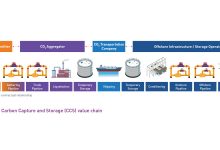Fit for 55 Package: Speeding up Decarbonization
In the European Commission work programme for 2021, the revisions and initiatives linked to the European Green Deal climate actions and in particular the climate target plan’s 55% net reduction target are presented under the Fit for 55 package.
The European Parliament adopted the new EU climate law, a project that raises the target of the European bloc to reduce greenhouse gas emissions (GHG) by 2030 from 40% to at least 55% compared to 1990. Under the new climate law, which João Pedro Matos Fernandes, Minister of Environment and Climate Action, called the “law of laws”, the EU takes the firm commitment to become climate neutral by 2050. With the adoption of Fit for 55 package, the European Commission should re-examine and, as appropriate, propose the revision of all relevant policy instruments to achieve further emission reductions in the perspective of 2030.
Achieving the target to reduce by 55% greenhouse gas emissions will contribute to the further reduction of air pollution, reaching a total reduction of 60% by 2030, compared to 2015. Therefore, the costs of harmful effects on health could drop, compared to 2015 levels, by at least EUR 110 billion. Boosting actions to combat climate change would also reduce the costs of controlling air pollution by at least EUR 5 billion in 2030 and would contribute to mitigate other environmental problems, such as soil acidification, according to the European Commission.
Energy sector, the greatest reduction potential
By 2030, it is expected that the EU share of electricity production from renewable sources will be at least double compared to the current level of 32%, reaching approximately 65% or more. The increase in the level of ambition in terms of climate from the current target for 2030 to 55% and achieving climate neutrality by 2050 would save EUR 100 billion in EU’s import bill during 2021-2030. The energy sector has the greatest potential of further reductions with low costs, beyond the existing policies, especially by avoiding fugitive (undirected, airborne) methane emissions from oil, gas and coal production and transport. These aspects will be addressed, among other things, in the future methane strategy.
Biological waste storage prohibited as of 2024
It is also expected that the waste sector will drastically reduce its emissions, especially due to the obligation of separate collection of biological waste as of 2024 and prohibiting its storage. Reductions will depend to a great extent on ensuring full compliance with the existing legislation. Turning waste into resources is an essential part of closing the loop in a circular economy, by reducing emissions throughout the industrial value chain. Moreover, wastewater treatment has an additional potential of cost-effective reduction, especially through a better management of sewage sludge.
Building renovation rate must be doubled
The construction sector, currently responsible for 40% of the final energy consumption and 36% of greenhouse gas emissions in the EU, has a major potential of emission reduction, in a cost-effective manner. Today, approximately 75% of EU building stock is energetically inefficient. Many houses are still heated by outdated systems that use polluting fossil fuels, such as coal and oil. To fully tap this improvement potential, the renovation rate, which is currently around 1%, should at least double by 2030.
Scientific Advisory Board at EU level
With the entry into force of Fit for 55 package, as part of the European Green Deal, a Scientific Advisory Board on Climate Change will be established at EU level. This independent board will have, inter alia, the task of providing scientific advice and report on measures, climate targets and indicative budgets to limit EU’s greenhouse gas emissions, as well as on their consistency with the European Climate Law and international commitments assumed by the EU under the Paris Agreement.
INECP to be updated
The Integrated National Energy and Climate Plan (INECP) of Romania will be updated in the context of the new targets to be assumed by the European Union. According to the current form of the plan, Romania has assumed a target of 30.7% for the share of renewable energy in 2030, compared to 24% set as target for 2020 and reached since 2017. The financial sources to support investments will come from the National Recovery and Resilience Plan and the Modernization Fund.
CO2 emissions fell by 5.2 Mt in Romania
According to EU-ETS data on carbon allowances traded in 2020 published by the European Commission, in 2020 Romania registered a decrease of 5.2 Mt of carbon dioxide emitted into the atmosphere by industrial facilities, according to an analysis by Bankwatch. A total of 32 Mt of CO2 was emitted, compared to 37 Mt in 2019. Most industrial producers have reduced their emissions compared to previous years, especially coal-fired electricity producers, which have seen production declines amid declining electricity demand during the Covid-19 lockdown. However, coal is still ranking first in the top of industrial polluters. In 2020, coal-fired power plants in Romania had a production of 8,329 GWh and emissions of 8.28 Mt CO2. According to the current form of INECP, Romania estimates that in 2030 it will have a coal-fired electricity production of 11,931 GWh and emissions will be around 11.86 Mt CO2.
The price of emission allowances surged by 135%
In the European Commission’s plan, emission allowances are a focal point of the decarbonization policy, and by imposing an additional cost on polluters, an attempt is being made to reorient them towards more environmentally friendly economic activities. According to an analysis by the brokerage firm XTB Romania, the price of allowances increased by 135% compared to 2020, to EUR 52.73, and could reach EUR 70 by the end of the year.
The increase in the price of allowances was supported by the recovery of economies, which took place earlier and with a greater speed than the markets expected, the quoted analysis also shows.
Non-polluting car purchases become mandatory
The Executive adopted a legal act to green the car fleet in state institutions and companies, according to EU Directive 2019/1161. The deadline for adapting the domestic legislation to the EU law is August 2, 2021, date after which the Government risks triggering infringement proceedings. The measure will lead however to an increase in expenses for vehicle purchases, which in Romania’s case would be difficult to bear, especially by state-owned companies, many of them facing major financial problems.
More non-polluting vehicles in circulation
From August 2, 2021, in public or sectoral vehicle procurement tenders, contracting authorities and contracting entities will be required to comply with a number of minimum targets related to the share of non-polluting vehicles purchased. Therefore, the draft GEO establishes that 18.7% of light vehicles purchased from August 2, 2021, until December 31, 2025, will have to be non-polluting, following to maintain the same quota in the period January 1, 2026 – December 31, 2030. As regards the procurement of non-polluting heavy vehicles in the N2 and N3 categories (utility vehicles), the share of non-polluting vehicles must be 6% during August 2, 2021 – December 31, 2026, and 7% during January 1, 2026 – December 31, 2030. Also, 24% will have to be the share of non-polluting heavy vehicles in the M3 category (buses), of the total number of heavy vehicles included in this category, which are subject to public and sectoral procurement contracts awarded from August 2, 2021, until December 31, 2025, the share following to increase to 33% by December 31, 2030. Army vehicles and those used by the General Inspectorate for Emergency Situations (ISU) will be exempt from these environmental obligations.
How much would it cost in case of failure to comply with the imposed deadline
EU Directive 2019/1161 was adopted on June 20, 2019, and published in the Official Journal of the European Union on 12.07.2019. Failure to comply with the deadline of August 2, 2021, for the adoption of national legislation in accordance with the provisions of the directives is one of the most serious violations, and the infringement procedure can quickly move from the pre-litigation phase to the litigation phase, completed with conviction by the Court of Justice of the European Union (CJEU) in a relatively short time, is shown in the explanatory memorandum of the draft GEO. If it notifies the CJEU, the European Commission may propose in respect of Romania a lump sum of at least EUR 1,723,000 and penalties between EUR 2,082 and EUR 124,900, per day of delay, considered from the date of the reasoned opinion, sanctions that could apply cumulatively to our country, given that, since 2017, the European Commission has asked the CJEU to apply both the lump sum and delay penalties.
Romania, without a green procurement plan
On the other hand, Romania is among the last three EU countries that do not have an Action Plan for Green Public Procurement. At European level, the amount spent annually by authorities is on average 16% of GDP. In Romania, it reaches almost 19% of GDP – which means a huge volume of products, services, works purchased by authorities, with a major impact on the environment. The pace of green public procurement in Romania is extremely slow compared to the urgency with which measures on climate neutrality targets must be implemented, which thus cannot be achieved by Romania until 2050 (according to the EU objective). This is the conclusion of the first National Study on Green Public Procurement in Romania, conducted by ARDLD – Romanian Association for Sustainable Local Development and ONV LAW. The European Union requires Member States to have at least 50% of total public procurement green, and in national legislation there is a 2018 Order requiring public authorities to comply with a number of minimum environmental protection requirements for 6 categories of products and services (printer paper, furniture, food and catering services, transport vehicles, cleaning products and services, office IT equipment). So far, there has been no formal instrument for measuring compliance with this obligation by authorities. Member States must adopt a National Action Plan for Green Public Procurement and most Member States are already at the 4th or even 7th edition of such plans (22 states).
CJEU has convicted Romania for pollution
This year, on April 30, the Court of Justice of the European Union published the Decision on the conviction of Romania for non-compliance with Directive 2008/50/EC on ambient air quality, the decision referring to exceeding the maximum limits allowed for PM10, in Bucharest, in the period 2007-2016, but also to the problems that the country registers in the process of combating pollution. In CJEU’s presentation, one of the observations underlines the minimal impact of the ‘Rabla Program’ which, although applied for 12 years, in Romania three times more used cars are registered than new cars, and the vehicle fleet is one of the oldest in Europe.







